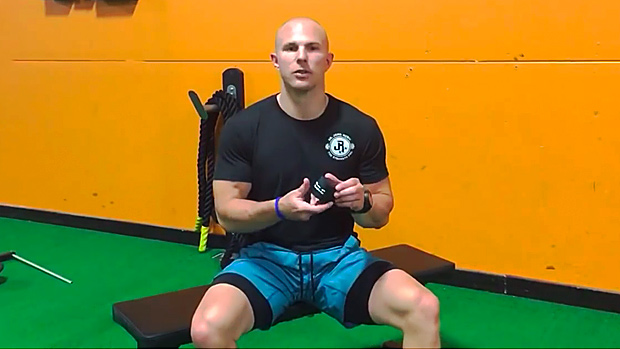My life changed when I read Earl Nightingale's Lead the Field. Nightingale, a survivor of the attack on Pearl Harbor, was a pioneer of motivational work. His key point can be summarized like this:
"We become what we think about."
I've often argued that we need to spend more time thinking about our training, and below we'll look at three ideas in each of the three key areas of strength training – repetitions, workouts, and programming.
1. Use Countdown Reps
A few years ago, Brian Oldfield (former world record holder in the shot put) and I were sitting around talking about lifting. He told me about a Polish school where the athletes were lifting. Instead of counting up like most Americans, the kids counted down, like a takeoff at NASA – 5, 4, 3, 2, 1. Brian loved the idea because the concept of "Blast Off" was perfect with the explosive nature of training.
I'm a huge fan of 5 x 5 workouts and this little change can be very valuable. I've always thought that the second to last set is the toughest mentally and this is a way to get around that problem.
2. The "And-One" Method
Bill Witt, a throwing-coach legend, gave me another idea that deals with the higher reps often use for hypertrophy. But for those of us who've spent our lives thinking that 5 reps qualifies as high reps and anything above 6 reps is cardio, it takes a mental shift to get those higher reps in during a workout.
Bill's simple answer is "and-one." "And" is the first rep and "one" is the second. A set of 10 looks like this:
"And-One-And-Two-And-Three-And-Four-And-Five."
You've done 10 reps, but you've only counted five. Ten reps can be a struggle for me by rep 8 or 9, but this method somehow tricks the mind. Much of training is a mind game, so accept it and play with it.
3. Embrace "Ish"
Steve Ledbetter has an idea that really works well with competitive athletes who aren't competing in the Iron Game. He simply says "ish."
The best example of "ish" is John Powell's approach to the 5 x 5. Each year, he'd set a goal of doing a weight for 5 sets of 5. If he chose 365 as his target weight, he'd plop down on the bench once a week and test himself.
- 365 for 4
- 365 for 3
- 365 for 1
- 365 for 1
- 365 for 1
He'd then add up the total reps of the workout (10 in this case). As the weeks and months progressed, he'd slowly work up into the teens, and then the low twenties. With a serious enough weight, it could take months to build up to the full 25 reps of a 5 x 5 workout. The upside of this workout may not be obvious, but it allows you to use heavy weights and slowly, steadily, build up the volume. Progress in life and the weightroom is as "ishy" as I can imagine.

1. Punch the Clock
I've been preaching the idea of "punch the clock" workouts at T-Nation for almost a decade. Those are sessions where you just show up and do the work. If you had a plan, you followed it. If you had a preprinted workout, you finished it.
Like a craftsman, much of our training is going to be showing up and doing stuff. It's also the kind of training that builds a reliable system over time. But there are times that you need to leave it all on the floor and sadly, in my second thought below, "leaving it all on the floor" can actually happen.
2. Perform Challenges
I like to call these workouts and short windows of training "challenges." A while back, T-Nation released my Farmers Walk Challenge and my 315 Deadlift Challenge. What fun they are!.
I also call these "Kill Yourself Workouts." They're great, but you can only do these for about three weeks before you die.
In Junior High, our first football game was cancelled, so our coaching staff decided to sneak in a few extra days of double sessions. We had three and a half weeks of two-a-day training sessions and our team dropped from 70 football players to about 25. Our season was a disaster, as we could never really come back from the load of all the training.
Most gyms that push "balls to the wall" training every session tend to have huge dropout rates, lots of physical therapy issues, and tend to close rather quickly. You certainly can do anything, but there's wisdom in not doing everything all the time.
3. The Hangover Rule
I'd like to introduce you to "The Hangover Rule." I've had conversations with people from all kinds of sports and I noticed a pattern – their lifetime best effort was often performed the morning after a series of bad decisions, many of them being made at something like a bachelor party. Many of the stories included puking in flowerbeds, so perhaps that's the actual secret, but more likely it's this:
Expecting nothing or very little from a training session or competition often allows one to stretch and expand far beyond the usual constraints.
Do you have to be hung over? No. When I was 18 my coach left on a road trip and I had to train without him. When I walked in the door, my clean and jerk PR was 270 pounds. But I was feeling good and I clean and jerked 271 for a new record. It felt easy, so I did 282. Then I made 292.
Dan Curiel walked in and said, "Try 137.5 kilos. You can make it." That's 303 pounds. I made the lift and broke the 300-pound barrier. I'd added 33 pounds to my personal record in half an hour.
Why? How? Don't know and don't ask. I've learned that extraordinary training sessions and days just pop out of nowhere and you have to enjoy your dance with these rare moments of life.

1. Look for Gaps
In programming, I keep my eye on two basic concepts that open the way for a third. First, I'm all about looking for gaps in training. Gaps consist of anything you should be doing, but aren't doing. Here's my list of the fundamental human movements:
- Push
- Pull
- Hinge
- Squat
- Loaded Carry
- (Everything Else)
Most people skip squats and loaded carries. I've argued for years that just adding goblet squats and farmers walks to workouts will take care of most training problems.
When Mike Brown and I train, he does the math after every session to see if there's balance across our movements. It's always a challenge, of course, to judge a 700-pound deadlift (hinge) against light goblet squats and see if there's balance, but just looking for gaps is my sole goal.
2. Meet the Standards
Next, logically, come the standards. I've worked on dozens of standards and I've shared them with T-Nation readers in the past.
For instance, I've found that when a high school boy does over 200 pounds in the bench press, clean, and front squat, good things seem to happen. Here's my "Big Blue Club," the basic standard for being a Varsity athlete:
- Power Clean: 205 pounds
- Deadlift: 315 pounds
- Back Squat: 255 pounds
- Front Squat: 205 pounds
- Standing Press: 115 pounds
- One-Arm Bench: 70 pounds (5 right/5 left)
- Power Clean & Jerk: 165 pounds
- Bench Press: 205 pounds
This should be easy enough for the boy to do all in one training session. I also have standards for push-ups (45 in a minute), pull-ups (5 real ones), and horizontal rows (24 in a minute. I keep the feet on a bench so it doesn't become a leg exercise).
I continue to work on standards for adults that can include the untrained and the detrained as well as those on the road to mastery.
3. Trust Your Intuition
You must trust yourself and train with intuition. A decade ago, it was called "instinctive training," but it's simply this – when you've put the time, effort, and energy into your training, you can sometimes "get a hint" that you need to do X, Y, or Z.
Many of my morning sessions are done with a group of people from various ages and athletic backgrounds. I often ask, "Does anyone need to work on anything?" Sometimes a participant will say something very simple and direct and the group will all start working on this issue or problem. Generally, within a few minutes, we all agree that we needed the same corrections.
Now that doesn't mean every day is going to be arm day because the Force is telling you to work your biceps.
If you keep a running log of checking your gaps and trying to fulfill certain standards, you can allow yourself a lot more flexibility in your training because you can see over a week or month whether your "instinct" is right or wrong.
I've never thought it was wrong to focus on an issue, weakness, or gap for up to two years to bring it up to standard. Your strengths won't go anywhere. In fact, it tends to improve when the whole system is improved. So, when it comes to training on intuition, "Trust, but verify."
I spend considerable time simply "thinking" about how to make my training and my athletes' training better. I urge you to do the same. It's quality time that might be far more meaningful than much of what you do in the gym each day.




